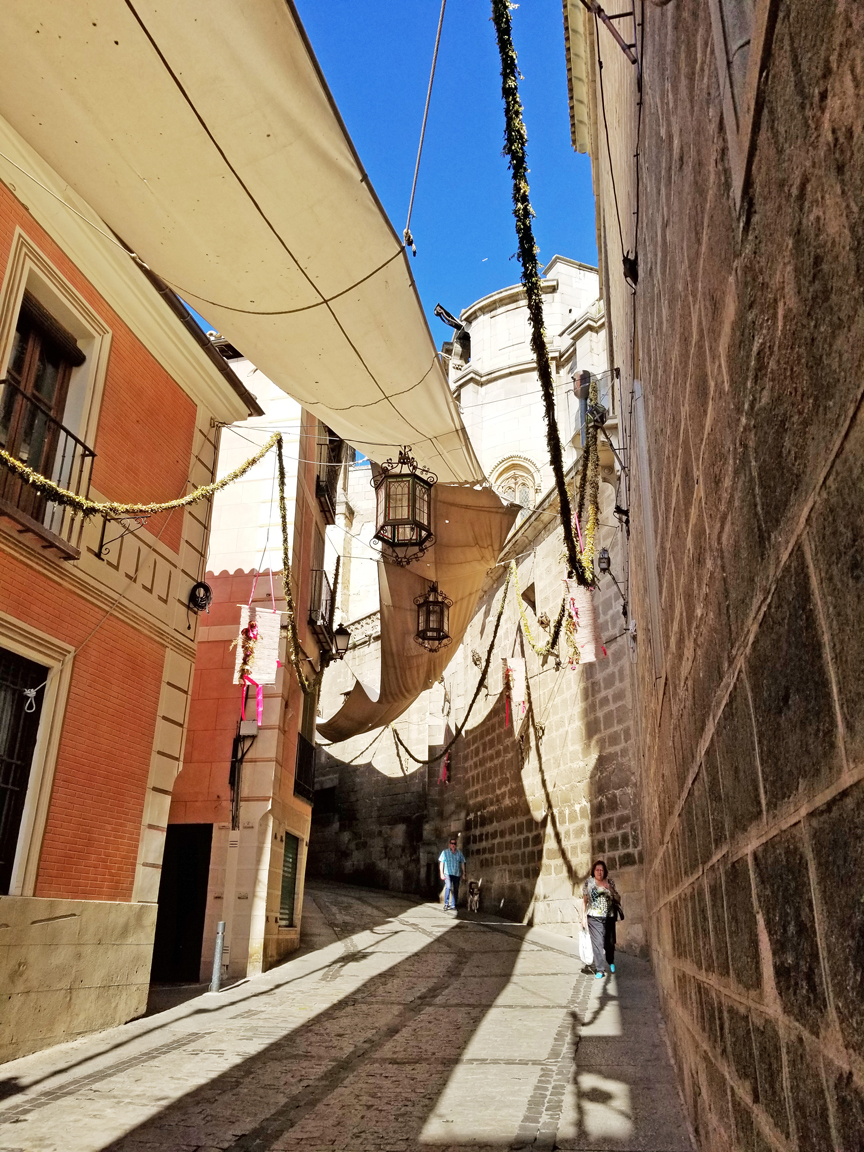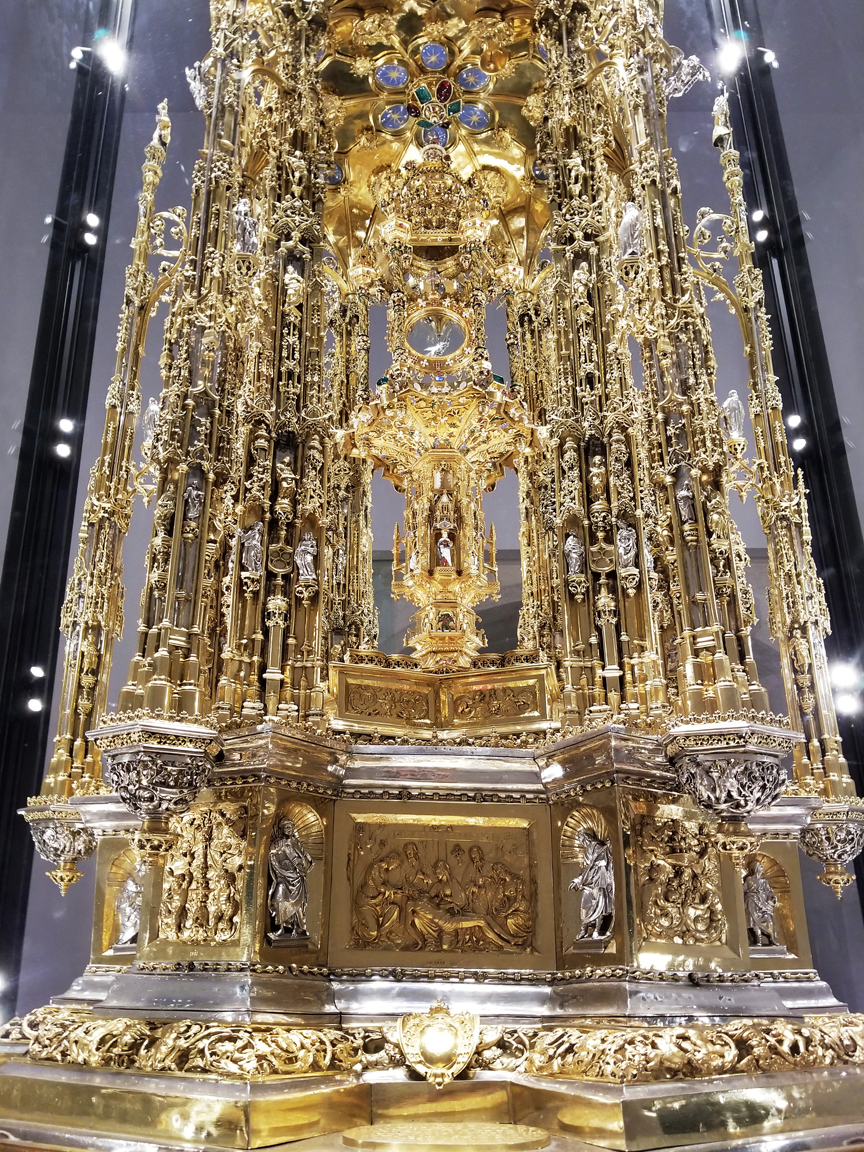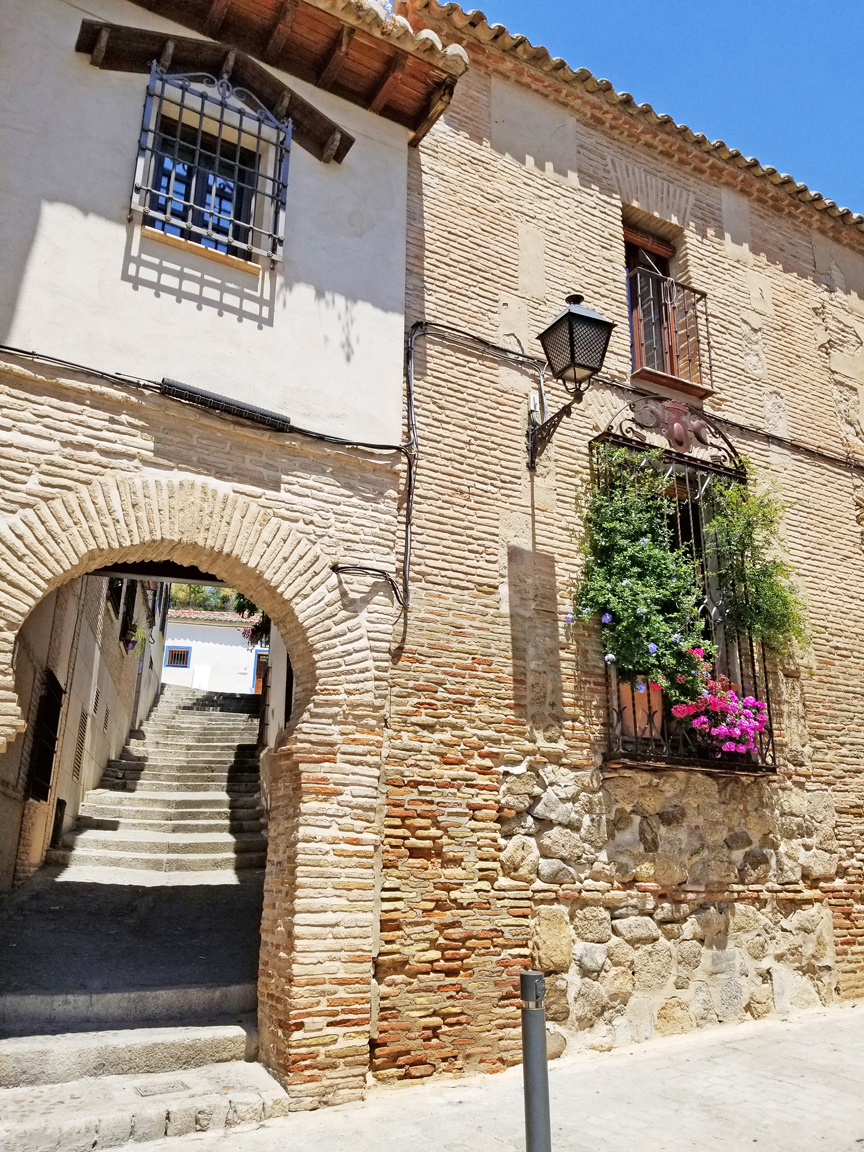A View of Toledo
As I was staying not too far from Atocha Station and had already booked and printed my ticket for the 8:50 train to Toledo, I figured I could set my alarm for 8:00am. I made it to the metro by 8:30. The metro took a bit longer than I'd anticipated and once at Atocha Renfe, I couldn't find the track. I got in line to go through security upstairs and heard a lady tell a German girl who'd just reached the scanners that the train to Toledo was located downstairs. Luckily, at the bottom of the escalator, a station guard helped me, walking me down a corridor, then pointing out where I needed to go. It was - of course - the very last gate. I ran, in sandals that were never meant for running. But I made it - last person on! For every subsequent trip in Spain, I arrived to the station an hour early and enjoyed a leisurely breakfast instead.

The ride to Toledo only took about half an hour. Toledo's station was a charming Neo-Mudéjar building with coffered ceilings, horseshoe arches and stained glass. Rather than hike up to the city, I decided to take a bus to Plaza de Zocodover.

The ride up had some amazing views, but I was mostly skirting around conversation with a creeper that sat next to me. He seemed sweetly harmless, but it was annoying to have to dedicate mental energy in any direction other than looking at the scenery and taking photos. I did manage to get a good picture of the Puerta de Bisagra, miraculously. The bus stopped in the old city and my new "friend" said goodbye and headed to work. I dropped by the tourism office, then walked toward the cathedral.

The streets surrounding the cathedral were decorated with garlands of herbs and dried flowers, woven straw mats, and wreathes of fuchsia netting. At the time I didn't know if this was for a festival or if the decorations stay up year round. I looked it up later - Corpus Christi had been two weeks earlier. It's probably Toledo's biggest festival, and Toledo is *the* place to celebrate it. Corpus Christi is a feast to celebrate blessed bread and wine turning into the Eucharist - the body and blood of Christ in Catholic doctrine. Following the end of mass, the sacrament is processed through the streets. You might think a parade to showcase a tiny wafer of bread doesn't really make sense. Just wait a few paragraphs...


I found the tourist entry to the cathedral. On the opposite side of the street was the shop where you buy your tickets. It was still a few minutes till 10:00 and there was already a short line. I went ahead and got in it, figuring the line would only get longer as the day progressed. If I were to do it again, I would save the cathedral for the afternoon - the building was dark and cool and Toledo in the summertime is decidedly the opposite. The ticket office finally opened. Admission was expensive, at €10, but you also received an audioguide in exchange for your ID.


The Catedral Primada Santa María de Toledo is the pinnacle of High Gothic architecture in Spain. It’s also one of the largest cathedrals in the country and one of the most important, given Toledo’s history as the center of Catholic faith following the Reconquista. It was built between 1226 and 1493, on the site of a former mosque.
The interior of the cathedral was beautiful. There were loads of 'No Photo' signs, but walking in, I immediately saw about 100 snapping cell phones in the hands of a nearby Chinese tour group. Literally everyone was taking pictures... so I did too. I started down the right side aisle of the nave, following my audioguide. It was really longwinded. This being the first cathedral I'd visited in Spain, I did make a point of seeing everything mentioned, even if it meant fast-forwarding the guide in places.


'El Transparente' is probably the most famous and unique feature of Toledo's cathedral. It's essentially a giant, decorative skylight located in the ambulatory, or curved end of the church. An architect and sculptor named Narciso Tomé cut a hole in the roof of the ambulatory and a corresponding one in the altar on the opposite wall. It allows light to flow through both windows, onto the tabernacle, where the Eucharist is kept. (Envision Indiana Jones and the Staff of Ra - just less dramatic.) It was added around 1730, by request of the Archbishop of Toledo, Cardinal Astorga y Céspedes, who is buried at the foot of the altar. Both walls are filled with gold and stucco angels swirling around the marble architectural features in true Baroque fashion.


Off to the right you can also find the Sacristy and the Vestuary, which house works of art by El Greco, Van Dyck, Goya, Titian, Velázquez, Bellini, Raphael, and (possibly) Caravaggio. In the treasury, you'll find an insanely large and detailed monstrance, made of silver and gilded in gold. Remember that parade for the communion wafers? *This* is what gets carried down the streets of Toledo - much more impressive. It was the first of many times I thought, "Oh, *this* is why they colonized half the Americas," while traveling around Spain.


There were several other neat bits, like the incredibly detailed Retable, the Mozarabic chapel in the nave, the gorgeous artesanado ceiling in the Chapter House, and the peaceful cloisters (though the colorful Chapel of Saint Blaise was closed). By this time, I'd spent a couple of hours in the cathedral and decided it was time to move on to explore the rest of Toledo.


After exploring more of Toledo's three cultures in the southwest corner of the city, I was beat. It was boiling hot and most shops had closed for siesta. I decided to return to the station and purchase a ticket for the 4:30 train. Once at the station, I discovered that train wasn't available for whatever reason - and the next train wasn't for two more hours. I went ahead and purchased the ticket, a bit miffed, but then I realized I could use the time to walk up to the Puente de Alcántara, the famous bridge I'd missed getting a picture of thanks to the bus creeper.


Though I was coated with sunscreen, I could feel myself baking - luckily, much of the path up to the overlook of the Rio Tajo (or Tagus) is lined with flowers and trees that provide some shade. The walk itself wasn't bad. I wandered across the bridge, snapped a few pictures, and decided to head back before I fried.


I was just wondering how I was going to kill an additional hour and a half when I heard the siren song of World Cup soccer. I literally climbed through the shrubbery and ran across the road to get to the hole-in-the-wall bar where it was playing. I spent the next 90 minutes watching Argentina play Iceland and drinking a tinto de verano. The timing ended up being perfect - I walked back to the station and boarded the train to Madrid in plenty of time.


Comments
Post a Comment